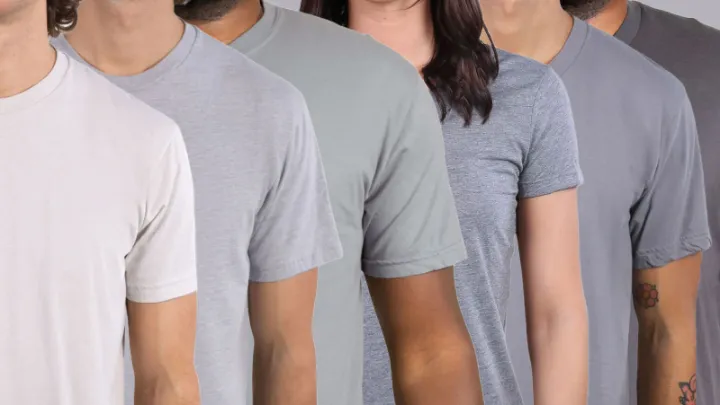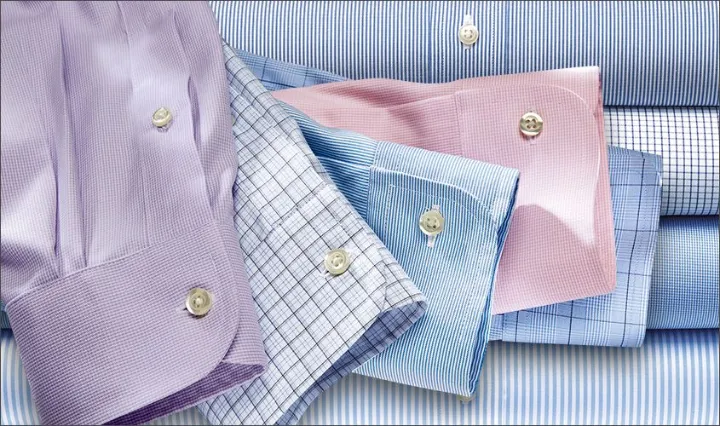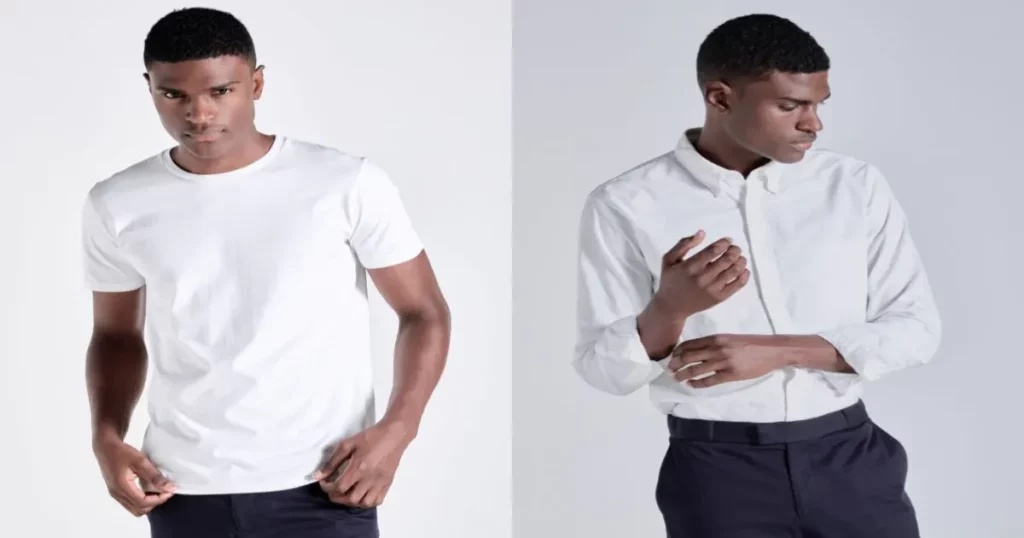No products in the cart.
Blog
Shirt vs T Shirt: Understanding The Differences
When choosing the right clothing for various occasions, one often encounters the dilemma of choosing shirt vs T shirt. Both garments have their unique characteristics and are suitable for different situations. In this article, we’ll delve into the distinctions between shirt vs T-shirt to help you make informed fashion choices.
What Is a Shirt?

A shirt is a type of clothing typically worn on the upper part of the body. It is a garment that covers the torso and often extends down to cover the waist and hips. Shirts are usually made of various materials, with cotton being one of the most common choices due to its comfort and breathability.
Key characteristics of a shirt include:
- Button-Up Front: Shirts typically have a button-up front, allowing the wearer to open and close the shirt using buttons or snaps. This feature distinguishes shirts from other types of tops like T-shirts or pullovers.
- Collar: Many shirts feature a collar that frames the neck area. The collar can come in different styles, such as the classic pointed, spread, or mandarin, depending on the shirt’s design.
- Long Sleeves: While there are short-sleeved shirts, the term “shirt” often implies a garment with long sleeves that cover the arms. However, short-sleeved shirts are also common and provide a more casual look.
- Formal and Casual Varieties: Shirts come in various styles and materials, making them suitable for both formal and casual occasions. Formal dress shirts are often made from cotton, silk, or linen and worn with suits or dress pants. Casual shirts can be made from more relaxed fabrics and are appropriate for everyday wear.
- Versatility: Shirts are versatile garments that can be dressed up or down. They can be paired with various bottoms, including slacks, jeans, skirts, or shorts, to create different looks for different occasions.
What Is T-Shirt?

A T-shirt, often referred to as a “tee,” is a type of casual and comfortable shirt that is typically made of soft and breathable fabric, such as cotton or jersey knit. Several key features characterize T-shirts:
- Short Sleeves: T-shirts have short sleeves, which provide a relaxed and informal look. The sleeves typically cover the shoulders and upper arms but end above the elbow.
- Round Neckline: The neckline of a T-shirt is usually round and is commonly referred to as a “crew neck.” However, there are variations of T-shirts with different necklines, including V-neck and scoop neck styles.
- Pullover Design: T-shirts are pullover garments, meaning they do not have a button-up or zippered front like traditional shirts. They are slipped on over the head.
- Casual Wear: T-shirts are primarily designed for casual wear. They are comfortable, easy to put on, and are often used as everyday attire. T-shirts are commonly worn with jeans, shorts, or casual pants.
- Variety of Styles: T-shirts come in various styles, colors, and designs. They can be plain and simple and feature graphics, logos, slogans, or patterns, allowing individuals to express their style and interests.
- Versatility: T-shirts are highly versatile and can be dressed up or down depending on styling. While they are inherently casual, they can be layered with other clothing items like blazers, cardigans, or jackets to create a more polished or smart-casual look.
- Comfort: One of the key attractions of T-shirts is their comfort. The soft and breathable fabrics used in their construction make them ideal for relaxed and comfortable wear in various settings.
Key Differences Between Shirt vs T Shirt
| Shirts | T-Shirts | |
| Fabric and Material | Shirts are typically made of a variety of fabrics, including cotton, linen, silk, or blends. They often feature a stiffer structure due to the fabric used, which can give them a more formal appearance. | T-shirts are primarily crafted from soft, breathable materials like cotton jersey.Their fabric is lightweight and stretchy, providing a casual and comfortable feel. |
| Style and Fit | Shirts come in various styles, such as dress shirts, button-downs, and Oxford shirts. They tend to have a tailored fit, with options for slim, regular, or relaxed fits. Shirts often include collars, cuffs, and buttons for a more sophisticated look. | T-shirts have a simple and casual design with a round neckline and short sleeves. They offer a relaxed and comfortable fit, typically without elaborate tailoring. T-shirts are known for their versatility and come in a wide range of colors and graphics. |
| Occasions and Dress Codes | Shirts are ideal for formal and semi-formal occasions, including business meetings, weddings, and professional settings. They are often a go-to choice when you need to dress up and maintain a polished appearance. | T-shirts are perfect for casual and everyday wear, such as running errands, lounging at home, or attending relaxed social gatherings. While T-shirts can be stylish, they are generally considered less appropriate for formal events. |
Fabric and Material

Shirt:
- Shirts are typically made of a variety of fabrics, including cotton, linen, silk, or blends.
- They often feature a stiffer structure due to the fabric used, which can give them a more formal appearance.
T-Shirt:
- T-shirts are primarily crafted from soft, breathable materials like cotton jerseys.
- Their fabric is lightweight and stretchy, providing a casual and comfortable feel.
Style and Fit

Shirt:
- Shirts come in various styles, such as dress shirts, button-downs, and Oxford shirts.
- They tend to have a tailored fit, with options for slim, regular, or relaxed fits.
- Shirts often include collars, cuffs, and buttons for a more sophisticated look.
T-Shirt:
- T-shirts have a simple and casual design with a round neckline and short sleeves.
- They offer a relaxed and comfortable fit, typically without elaborate tailoring.
- T-shirts are known for their versatility and come in a wide range of colors and graphics.
Occasions and Dress Codes

Shirt:
- Shirts are ideal for formal and semi-formal occasions, including business meetings, weddings, and professional settings.
- They are often a go-to choice when you need to dress up and maintain a polished appearance.
T-Shirt:
- T-shirts are perfect for casual and everyday wear, such as running errands, lounging at home, or attending relaxed social gatherings.
- While T-shirts can be stylish, they are generally considered less appropriate for formal events.
How to Choose Between a Shirt and a T Shirt

Choosing between a shirt and a T-shirt may seem like a simple decision, but it often comes down to several factors, including the occasion, your personal style, and your comfort preferences. Here are more details on how to make the right choice between
Occasion:
- Formal Occasions: If you’re dressing for a formal or semi-formal event, a shirt is the preferred choice. Shirts, especially dress shirts, are designed to convey a polished and professional look. They are typically worn with suits, blazers, or dress pants and are suitable for events like business meetings, interviews, weddings, and other formal gatherings.
- Casual Occasions: On the other hand, T-shirts are perfect for casual occasions. They are comfortable and relaxed, making them ideal for everyday wear, hanging out with friends, running errands, or enjoying leisure activities. T-shirts are also popular choices for outdoor events, picnics, and trips to the beach.
Dress Code:
- Workplace Dress Code: If your workplace has a formal dress code, shirts are a must. They give a professional appearance and are often required in corporate settings. However, in workplaces with a more relaxed dress code, T-shirts may be acceptable on certain days or in creative industries.
Comfort and Breathability:
- Hot Weather: T-shirts are typically more breathable and comfortable in hot weather due to their shorter sleeves and lightweight fabrics. If you’re dealing with summer heat, a T-shirt can help keep you cool and comfortable.
- Cold Weather: Shirts, especially long-sleeved ones, are better suited for colder weather. They offer more coverage and can be easily layered with sweaters or jackets for added warmth.
Styling Options:
- Shirts: Shirts offer more versatility in terms of styling. You can tuck them into your pants for a neat and polished look or leave them untucked for a more casual appearance. Shirts also come in a wide range of colors, patterns, and styles to suit your fashion preferences.
- T-Shirts: T-shirts are more casual by nature, but they can be styled in various ways. You can pair them with jeans, shorts, or casual pants. T-shirts also provide a canvas for expressing your personality through graphics, logos, or slogans.
Personal Style:
- Classic vs. Casual: Consider your personal style. If you prefer a classic and sophisticated look, shirts may align better with your fashion choices. On the other hand, if you lean towards a relaxed and casual style, T-shirts are likely your go-to option.
Comfort and Fit:
- Fit: Pay attention to the fit of both shirts and T-shirts. A well-fitted shirt or T-shirt enhances your overall appearance. Make sure the shoulders, chest, and sleeves fit properly, and choose a length that suits your body type.
Color and Design:
- Color: Think about the color or pattern that complements your skin tone and style. Shirts come in a wide range of solid colors and patterns, while T-shirts can be found in various graphic designs and prints.
Conclusion
In conclusion, the choice between shirt vs T-shirt ultimately boils down to the occasion, your personal style, and your comfort needs. Shirts are the go-to option for formal events and professional settings, offering a polished and sophisticated appearance. On the other hand, T-shirts excel in casual and relaxed situations, providing comfort and versatility in styling.


